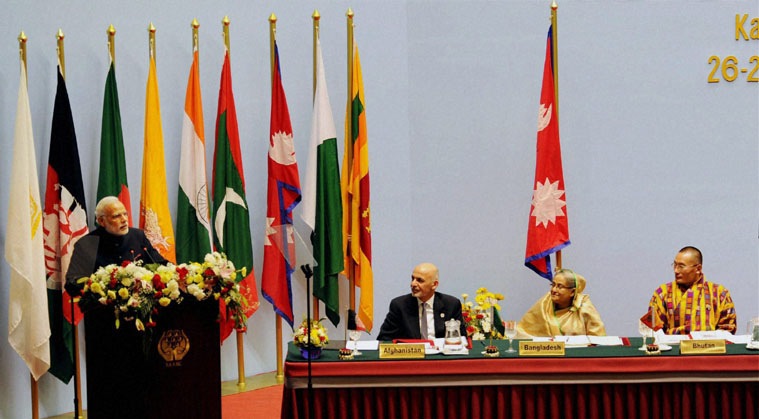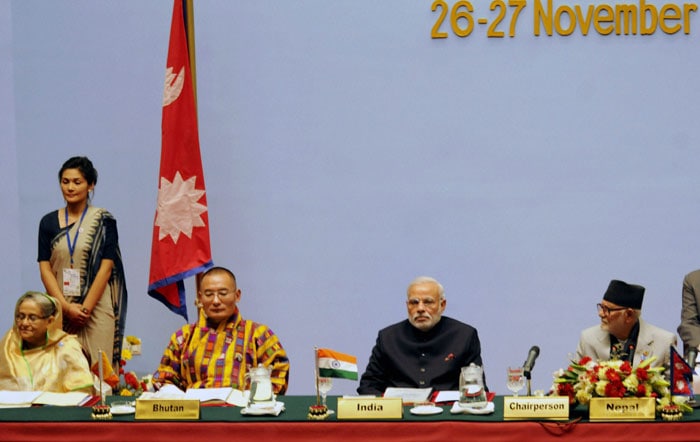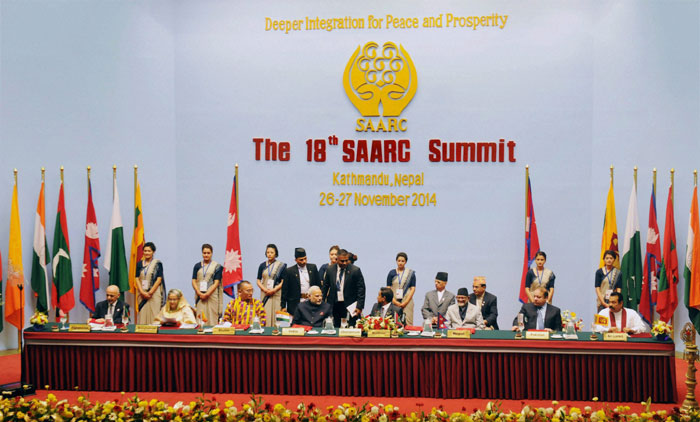Stay updated with the latest - Click here to follow us on Instagram
Modi at SAARC: Medical visas to easier business entry announced
Narendra Modi also assured all possible help to the grouping.
 Prime Minister Narendra Modi addresses the inaugural session of 18th SAARC Summit in Kathmandu on Wednesday. (Source: PTI photo)
Prime Minister Narendra Modi addresses the inaugural session of 18th SAARC Summit in Kathmandu on Wednesday. (Source: PTI photo)
Six months after meeting the SAARC leaders at his swearing-in ceremony, Prime Minister Narendra Modi on Wednesday spelt out his vision for SAARC, as he sought to change the narrative from “cynicism into optimism”, and said India would “do its part” to lead the eight-member grouping.
 Narendra Modi with Nepalese PM Sushil Koirala, Bhutanese Prime Minister Tshering Tobgay and Bangladeshi Prime Minister Sheikh Hasina at the inaugural session. (Source: PTI)
Narendra Modi with Nepalese PM Sushil Koirala, Bhutanese Prime Minister Tshering Tobgay and Bangladeshi Prime Minister Sheikh Hasina at the inaugural session. (Source: PTI)
“Hum paas-paas hain par saath-saath nahin. Saath hone se takat kai guna barh jaati hai (We are neighbours but we are not together… by staying together, our strength can increase manifold),” said Modi, breaking into Hindi, as he spoke from a prepared text in English at the 18th SAARC Summit here.
 Narendra Modi gestures during his address. (Source: PTI)
Narendra Modi gestures during his address. (Source: PTI)
“When we speak of SAARC, we usually hear two reactions — cynicism and scepticism. This, sadly, is in a region throbbing with the optimism of our youth… Let us work to change cynicism into optimism,” he said.
“India, too, has its share of responsibility — because of our size and location. I know India has to lead, and we will do our part. I hope, each of you will too,” said Modi in his maiden speech at the SAARC summit.
With Pakistan Prime Minister Nawaz Sharif seated on the dias, Modi recalled the Mumbai terror attacks — Wednesday being the sixth anniversary — but did not press the point by accusing any country.
 Prime Minister Narendra Modi with other SAARC nations leaders at the inaugural session of the 18th SAARC Summit in Kathmandu on Wednesday (November 26). (Source: PTI)
Prime Minister Narendra Modi with other SAARC nations leaders at the inaugural session of the 18th SAARC Summit in Kathmandu on Wednesday (November 26). (Source: PTI)
“Today, as we remember the horror of the terror attack in Mumbai in 2008, we feel the endless pain of lost lives. Let us work together to fulfil the pledge we have taken to combat terrorism and transnational crimes,” he said.
“If we are sensitive to each other’s security, and the lives of our people, we will deepen friendships, spur cooperation and advance stability in our region,” he said, making his message quite clear to the South Asian neighbours.
In fact, with Sharif listening in, he carefully chose the example of trade between India and Pakistan through circuitous routes to drive home the advantage of the economic integration of the South Asian region.
“Today, goods travel from one Punjab to the other Punjab through Delhi, Mumbai, Dubai and Karachi — making the journey 11 times longer and the cost four times more… Just think of what we are doing to our consumers — and to our environment,” he said.
“We must shrink the distance between our producers and consumers and use the most direct routes of trade,” he said, adding that infrastructure was the region’s “greatest weakness” and its “most pressing need”.
“It is still harder to travel within our region than to Bangkok or Singapore, and, more expensive to speak to each other,” he said, addressing the delegations from South Asian countries as well as observer countries like China, US, Australia, Iran and European Union among others.
During his 23-minute speech, Modi also proposed certain initiatives by the Indian government towards SAARC.
Sharif, in his intervention, called for a “dispute-free” South Asia.
“My vision for our region is a dispute free South Asia where instead of fighting each other we jointly fight poverty, illiteracy, disease, malnourishment and unemployment,” he said.
Sri Lankan President Mahinda Rajapaksa praised Modi’s idea of a SAARC satellite, which would help in communication and disaster management.
The leaders are expected to meet again on Thursday at Dhulikhel for a retreat and unveil the Kathmandu declaration, which is expected to take into account the interventions from all the leaders.



- 01
- 02
- 03
- 04
- 05



























